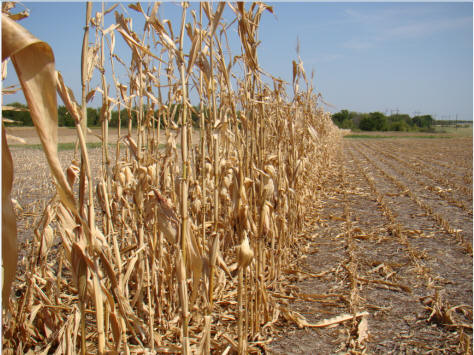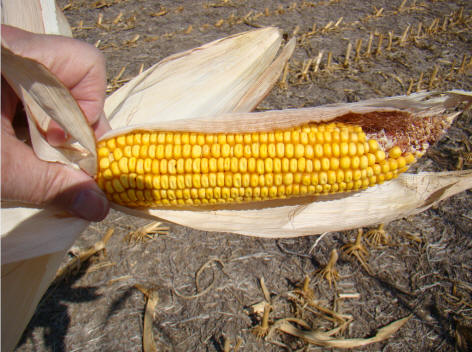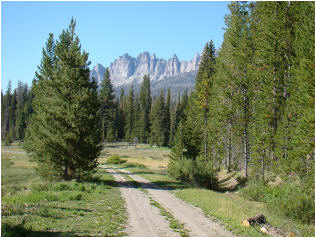August 2012 Trip
From Texas to Oklahoma, Kansas, Missouri, Iowa, Nebraska and Wyoming
August 2
Once again, we left Dallas at 5:30 a.m. headed north on U.S. 75 and stopped in McKinney, TX for breakfast at an IHOP. We were now driving a Ford F-150 Ecoboost which would get about 50% of the gas mileage of the Lincoln MKZ but had more room in the front seat to rest my legs.
We found our first corn field just south of Big Cabin, OK on U.S. 69. The following pictures show the field that had been harvested for silage and a few rows were left standing for the crop adjuster to see. In speaking with the farmer, he indicated that this field would normally not be ready for combining until early September.

The next picture shows the best ear of 10 which were shucked and the cannibalization of the ear because of the drought.

From Big Cabin, we took U.S. 169 north to Chanute, KS and then to the Kansas City area. All the corn fields were stunted from lack of water and had been completely fired. Many of the fields had been harvested for silage. The following picture was taken in a field just south of Chanute, KS where we found one lonely corn stalk that had some green left.

The next picture was taken near Greeley, KS looking south from a dirt road just off U.S. 169.

The height of the corn stalk in both the above and below pictures was about half normal height. The F-150 picture provides a height reference. In most fields which we saw up to and south of Liberty, MO the plants looked stunted.

North of Liberty on I-35 after Kansas City, we began to see stalks that were not completely fired. However, there were problems with the size of the corn as indicated by the following picture.

The rolling terrain of northern Missouri and southern Iowa made it difficult to judge the height of the corn plants but I would estimate that after leaving Bethany, Mo corn plant height began to move toward normal. It was nearly dark at 9:15 p.m. when we rolled into Webster City, Iowa. Total mileage was 747.
August 3
The fields around North Central Iowa were already showing firing at the roots which is about four weeks premature.

As we walked into the fields, corn yield variability became very apparent even in fields that looked green from the road as shown in the following picture. These ears were picked from one of the best looking fields in North Central Iowa.

After lunch and a car wash to get the F-150's white color back from the brown dust which it picked up on all the Iowa county roads we traveled in the morning, it was back to U.S. 20 headed to Nebraska. Stopping in every county from Rockwell City, IA to Norfolk, NE the same variability was evident in ear size on dry land corn. Irrigated corn fields seemed to be doing better in Nebraska around Sioux City but still had suffered from the extreme heat of July 2012 as shown in the following picture.

It would appear to me that with the ear size so variable that it will be extremely difficult to predict the corn yield in 2012 until it is harvested and in the bin. Ear size, kernal size, weight and cannibalization will all make estimates very difficult. The USDA started the year with 166 bu/acre as the trend line for corn. Three weeks ago they lowered that estimate to 144 bu/acre. Based upon the discussions and my personal observations, the corn harvest may well be under 100 bushels/acre.
About 9:30 p.m. we pulled into the Comfort Inn in Valentine, NE for the night. Total mileage was 444.
August 4
We left about 7:00 a.m. headed towards Jackson Hole, Wyoming on U.S. 20. Had breakfast in Charron, NE and noticed that most of the crops and range land suffered from the ravages of the drought unless the land was irrigated. The corn yield potential is not likely to affected positively if rain occurs in the next few days. However, favorable rains might help the soybean yields from plummeting to the teens in yield. While some areas like Mississippi and Arkansas show good yields, the total number of acres of both crops in those states is unlikely to overcome the damage in the Midwest bread basket.
Had lunch in Douglas, WY and then it was on to Dubois and Jackson Hole. The following is a picture of a Wyoming superhighway near the Togwotee Pass on U.S. 26.

After topping the Togwotee Pass and headed down the Teton Valley to Moran Junction, visibility was down to about a mile in smoke and haze. For the first time that I recall except during winter storms, I could not make out the Grand Teton peak or any of the Teton range. After fighting the Saturday traffic in Jackson and checking room prices, we decided to push on to Idaho Falls for the night. We arrived at 9:00 p.m. after driving only 444 miles.
Return to the 2012 Trip Log, click here.
For Centennial Valley, click here.
For Magruder Road Corridor, click here.
Fred Richards
August 28, 2012
Corruptisima republica plurimae leges. [The more corrupt a republic, the more laws.] -- Tacitus, Annals III 27
"On the Road
Again!" was copyrighted by Adrich Corporation in 2012.
All rights reserved. Quotation with
attribution is encouraged.
![]()
Last updated - August 28, 2012